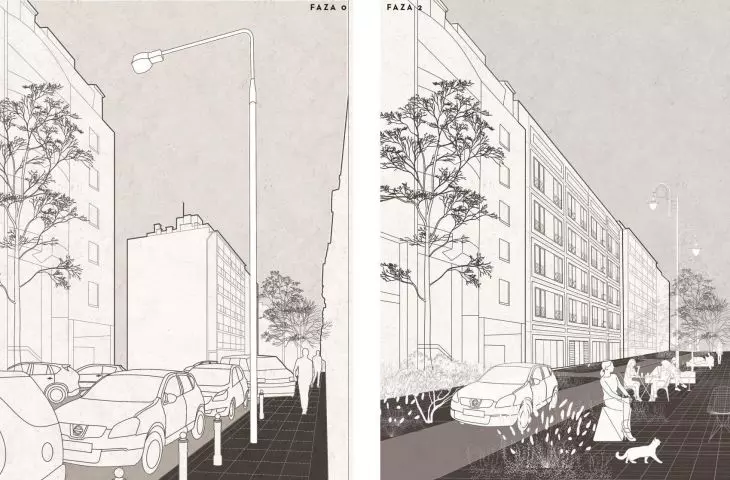Can parking be city-forming? How, by changing the layout of streets and reducing some parking spaces, can we create a new character for urban spaces? Finally, what are intimate parking lots and how can they help transform cities to, these cities are more pleasant.
"A network of city-forming intimate parking lots as a method of regaining the urban character of streets on the example of Warsaw," is the topic of the second degree thesis of Mateusz Niemirski, a graduate of the Faculty of Architecture at the Warsaw University of Technology. The diploma received an award in the "Diploma of the Year of the Warsaw Branch of SARP" competition for his master's thesis.
warsaw's problem
Warsaw is among the most motorized capitals in Europe. In 2016, there were 681 cars per 1,000 residents of the capital city. Nor do forecasts indicate a change in the upward trend of car ownership. How to reconcile car ownership and use in the city with the creation of recreational, pedestrian-friendly and greener spaces? Matthew Niemirski's basic idea was not to introduce revolutionary measures, but to make changes gradually. Privileging pedestrian traffic while allowing residents to own and use cars.
This is what Lwowska Street would look like after the changes proposed by the author
© Mateusz Niemirski
The designer conducted local inspections in Berlin, Hamburg, Potsdam and Amsterdam. He tried to pay attention to the existing parking structures, road layouts, public spaces, pedestrian areas and bicycle infrastructure in these cities. The author then focused on studying the quantitative status of parked cars in the area served - a section of the South Downtown district.
parking lots
Mateusz Niemirski compared Lwowska Street in Warsaw to Berlin's Carmerstraße. The slightly larger German street managed to introduce at least 4.5 meters of sidewalk, an area much wider than in Warsaw, where the width was only 1.5 meters. By creating intimate parking lots, built into the urban space, it is possible to hide 1320 parking spaces, reducing their number with a partial reduction from 3750 to 1900-2000.
The area covered in the author's thesis
© Matthew Niemirski
Camouflaged parking is a multi-level building, whose placement in urban space is easy due to its smaller size and the possibility of matching the facade to the street frontage. The author of the project proposes various solutions for modular intimate parking lots, differing in the number of segments, traffic layout, number of floors or walls with openings. Each of these structures can be adapted into residential, office or recreational buildings. In place of the reduced parking spaces, the author proposes to introduce vegetation, benches and new urban furnishings.
Interview with project author Mateusz Niemirski
Wiktor Bochenek: Can a parking lot be an urban-forming element and how could it be one?
Mateusz Niemirski: The parking lot itself can be a city-forming element, provided that it is a part of a broader and comprehensive effort. Otherwise, when it is a single object that simply serves the purpose of parking cars, it certainly cannot be said to be city-forming.
One of the most important objectives of the project is to change the functioning of the surrounding public space of the street immediately after the construction of a single building. This includes widening sidewalks, adding vegetation, creating spaces for gardens, etc., while reducing street-side parking spaces by up to 70%. The first floors of the facilities are always provided for commercial premises. In addition, the mere functioning of the facility as a parking lot would be only temporary - after some time, when the problem with the excessive number of vehicles in the city would significantly diminish, I assume a change of its function to one of the previously designed (apartments, offices, galleries, dormitory, etc.). In this approach to the subject of parking lots, it seems to me that they can be perversely called an element of the
city-forming element.
cross-section of modular intimate parking lots
© Mateusz Niemirski
Wiktor Bochenek: What made you choose the topic?
Mateusz Niemirski: In a nutshell - having to repeatedly trudge to my university through the 1.5m sidewalk of Lwowska Street and seeing that about 80% of its cross-section is given over to road infrastructure. I wondered if it was possible to approach the subject of reducing street parking spaces without triggering protests from nearby residents.
Wiktor Bochenek: What conclusions did you draw from your analysis of parking spaces?
Mateusz Niemirski: I made a study of the quantitative status of parked cars in the studied area in the southern downtown at two times of the day - during working hours and at night. The difference was about 23%. It can be assumed with some approximation that cars parked at night belong to local residents. This allowed me to assume an additional rate of reduction of street-side spaces as an element supporting the city's transportation policy and sustainable transport.
visualization of changes proposed by the author
© Mateusz Niemirski
Wiktor Bochenek: In the project you present a system of intimate parking lots in different modules. What do such parking lots consist of and how do they differ?
Mateusz Niemirski: The network design was intended to be introduced in densely built-up parts of cities. For this reason, I created a matrix of modules to be able to choose a facility that can be adapted to a specific downtown situation (the smallest module is only 8.5m by 14.5m). The modules take into account three different ways of future location of staircases and different possibilities of lighting the walls. The most important function of this matrix, however, is the ability to choose the later function of stage 2 (conversion of the parking lot into a residential building, for example). This makes it possible to significantly reduce the cost of redevelopment and make it profitable.
The plan for the changes on Wilcza Street with the introduction of an intimate parking lot
© Mateusz Niemirski
Wiktor Bochenek: What was the most difficult part of the job, and what are you most proud of?
Mateusz Niemirski: The most difficult, but at the same time the most rewarding was the search for a compromise solution to the problem of appropriation of public spaces by cars - that is, not revolutionary, assuming an immediate reduction, and not gradual, because in the Polish conditions of a huge increase in cars and attachment of Poles, this could stretch for a very long time. What I'm most proud of is the response - it seems that from the point of view of architectural projects the topic of car parking is not very thrilling, but in all the discussions in which I participated you could see a sincere interest in the topic and design solutions.
Wiktor Bochenek: Thank you for the interview!
































